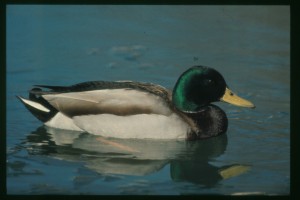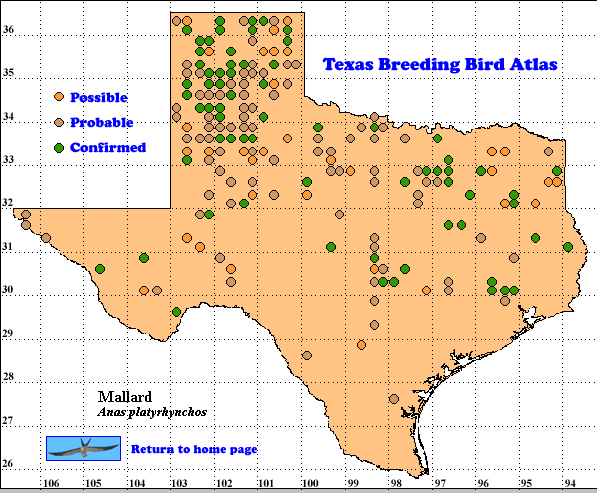The Mallard is the prototypical duck species of the Northern Hemisphere. It is the most abundant and widely distributed of the Anatinae, ranging from the Arctic to the subtropics in Europe, Asia, and North America. On the latter continent it reaches its zenith of abundance in mid-America between the Appalachian and Rocky Mountains (Bellrose 1976). The species winters throughout Texas, abundantly in some areas in the northern half, uncommonly to rarely in the southern third, and is a locally common breeder in some sectors (Lockwood and Freeman 2004). Well known as a wild bird, the Mallard is also familiar over a vast area because of occurrence of domesticated strains and self-tamed unconfined wild birds (Palmer 1976).
Because of this mix of wild and domesticated stock, it was sometimes difficult for atlasers to evaluate the status of birds found in or near heavily populated centers. This dilemma was emphasized by Pulich (1988) for the urban areas of Dallas and Tarrant counties, where some birds are the descendants of domestic stock that went wild. He feels most, if not all, nesting records from some areas of north central Texas may be Mallards diluted with domestic brood stock. The Texas Parks & Wildlife Department has in the past released in several counties, particularly in eastern Texas, brood stock reared from captive birds. Perhaps fortunately these releases faded out rapidly (fide C. Stutzenbaker).
DISTRIBUTION. Mallards were found in 226 survey blocks during the TABB project field work in 1987-1992. Broken down by physiographic regions, their distribution was: Staked and Pecos Plains (38%); Red Rolling Plains (26%); Glaciated Coastal Prairies (9%); Osage Plains (8%); Edwards Plateau (6%); Chihuahuan Desert and Mexican Mountains of Texas (5%); West Gulf Coast Plain (4%); Texas Coastal Prairies (3%); South Texas Brushlands (1%). Confirmation (CO) of nesting was made in 36% of the occupied quadrangles, and of those 42% occurred in the Staked and Pecos Plains and 20% in the Red Rolling Plains of the northwestern sector. Other than the Glaciated Coastal Prairies of the eastern sector (16%), the remaining confirmations were fairly well distributed throughout the other regions. No confirmed breeding records were from the South Texas Brushlands.
SEASONAL OCCURRENCE. Departure of the Mallard from its wintering areas begins in late February or early March (Palmer 1976), and nesting begins over much of its vast breeding range between 10 April and 30 April (Bellrose 1976). During the TBBA project, dates of nests with eggs ranged from 17 April (latilong 33096-A6) to 29 June (latilong 33101-F6), and recently hatched young as late as 8 August (latilong 35101- A5). A nest found 18 April (latilong 34102-H2) contained four Mallard and 12 teal eggs. These dates may be compared to Oberholser (1974) who gave an early egg date of February and small young of 11 August. Seventy-six percent of all confirmations of nesting were based on observations of broods and/or fledglings.
BREEDING HABITAT. The Mallard will accept waters of almost any kind for breeding and is catholic in its selection of nest sites, preferring upland to marsh. Critical are the presence of shallow-water feeding areas and availability of suitable nest sites. Studies show that nearly half of Mallard nests are located in vegetation between 33 and 61 cm (13 and 24 in) tall, two-thirds concealed on all four sides and about half also concealed from above (Johnsgaard 1975). Such concealment complicated nest-finding for atlasers as often a brooding hen would not reveal her presence until almost trod upon. Most nests are built within 91 m (100 yds) of water; however, the Mallard (and other ducks) may fly as far as 5 to 8 km (3 to 5 ml) from water areas in order to reach choice nest cover (Bellrose 1976). Recent programs involving artificial nesting structures show a high rate of occupancy and nesting success by Mallards (Ray and Higgins 1993).STATUS. The playa lakes region of the southern High Plains is the principal area of Mallard production in Texas. The species has been recorded in summer in all 26 counties of the Panhandle and nesting confirmed in all but five (Seyffert 1985). Breeding surveys conducted in 12 of the southwestern counties disclosed as many as1,528 broods and 10,048 ducklings (expanded data) produced in the best season of a 4-year study (Traweek 1978). A more recent study (1988-92) covering the western two-thirds of the High Plains from the northern Panhandle to south of Lubbock found Mallard breeding pairs the most abundant of 15 species of duck, the mean 0.14 pairs/km (Ray, J.D., H.W. Miller, and B.D. Sullivan, pers. comm.).
Yearly waterfowl production fluctuates widely, for playas in their natural state are intermittent systems that normally experience dry periods in summer months, usually in 3 of every 5 years. Lowered biomass in drier years, alteration of playa area for farming or grazing purposes and lowering of the Ogalalla aquifer by over- pump- ing are all negative factors for waterfowl production (Bolen et al 1979). The Conservation Reserve Program (CRP) has helped in offsetting these detrimental practices by providing grassland cover for breeding waterfowl around playas (Berthelsen et a! 1991).
In north central Texas, the Mallard is thought to have increased over the last 20 years, a phenomenon possibly attributable to a reduction of habitat in east Texas and an increase in permanent impoundments (Pulich 1988).
In summary, the TBBA project discovered a greater presence and density of the Mallard in the northwestern sector of the state than revealed by Oberholser (1974), and outside of the north central sector, a pronounced reduction in most other areas, particularly along the coast.
Text by Kenneth D. Seyffert (Posted with updates 2006).
Literature cited.
Bellrose, F.C. 1976. Ducks, geese & swans of North America (2nd ed.). Stackpole Books, Harrisburg, PA.
Berthelsen, P., L. Smith, and R. George. 1991. A plains trilogy: part I: grass. Texas Parks & Wildlife 49: 30-31.
Bolen, E. G., C. D. Simpson, and F. A. Stormer. 1979. Playa lakes: threatened wetlands of the
southern Great Plains, pp. 23-30, in Riparian and wetland habitats of the Great Plains. Great Plains
Agric. Council PubI. 91, U.S. Dept. Agric. Forest Service, Ft. Collins, CO.
Lockwood, M. W. and B. Freeman. 2004. The TOS handbook of Texas birds. Texas A&M University Press, College Station.
Oberholser, H. C. 1974. The bird life of Texas, Vol. 1. University of Texas Press, Austin.
Palmer, R.S. 1976. Handbook of North American birds, Vol. 2. Yale University Press, New Haven, CT.
Pulich, W.M. 1988. The birds of north central Texas. Texas A&M University Press. College
Station.
Ray, J. D. and K .F. Higgins. 1993. Waterfowl use of and production on nesting structures in South Dakota. Proc. South Dakota Acad. Sci. 72: 73-86.
Seyffert, K. D. 1985. The breeding birds of the Texas Panhandle. Bull. Texas Ornithol. Soc. 18: 7-20.
Traweek, M. S., Jr. 1978. Texas waterfowl production survey. Federal Aid Proj. No. W-
106-R-5. Final Rep. Texas Parks and WildI. Dept., Austin.

